Published Oct 16, 2004
Unlike other members of my family, I’ve never been particularly inclined to pursue a career in the military. That wasn’t enough to stop me, however, from a fun idea like traveling to the desert and running around to learn about one approach (the Marines’, obviously) to being a leader.
After Finals, on Wednesday, we took a bus down to Camp Pendleton in north San Diego county.
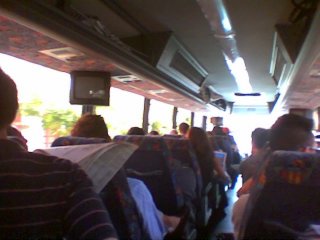
On the way down, we stopped for food. Once we got to Pendleton, three Marines pursuing their MBAs at Marshall spent over an hour helping us to understand Marine history and just how things work when you’re a jarhead. After the presentations, I made a rookie mistake: I volunteered. The Marines have this little trick they play — first they ask for volunteers, then, after you’ve volunteered, they tell you what you volunteered for. I volunteered and ended up being made head of a “fire team,” a group of five pople who would work together on the next day’s challenges.
Then they marched us down to a barracks and bunked all of us men in a “squad bay,” one of those long, open rooms that everybody bunks in:
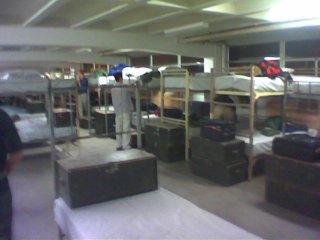
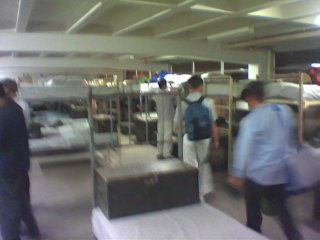
Everybody chose themselves a bunk bed, or “rack” as the technical term goes:
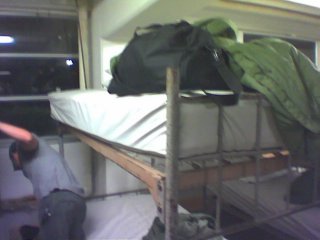
Every student was issued a sleeping bag, to go with said rack, and in which said student would then spend the hours from 11:30pm lights out to 5:30am reveille. That’s right, 5:30am; that’s the lifestyle that doesn’t attract me. But there was one part of the kit that was attractive, the helmet. Everyone dug the helmet!

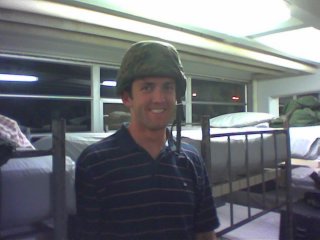
Of course, issuing all this “kit” leaves a mess. I volunteered again — this time, to have my fire team count all of the unissued kit and make sure that nobody got charged for any unissued “lost” equipment. I called my fire team around and broke the news soft; I said, “I’ve got good news and bad news. The good news is, I got us out of cleaning out the head in the morning. The bad news is, we have to police up the unissued kit.” I think anything sounded good after hearing about “cleaning out the head” (bathroom, including showers, toilets, etc.) and my team tackled the task with enthusiasm and efficiency.
Sleep was harder to get than I’d expected; I was amped up after a whole day of anticipation and, frankly, when you get a few dozen guys in one room you’re guaranteed some snorers. I woke myself up with the start of a snore once and I ended up spending the whole night sleeping on my side to make sure that I didn’t wake anybody.
Morning came too soon; 5:30 is early!

They marched us down the the mess hall where we had eggs and a starch and exactly one meat option, not two. Then they marched us to a classroom for a few hours of instruction on Marine leadership and maneuver warfare.

The morning’s instruction, given by two of our three class Marines and one of the base’s Colonels, was quite instructive.
 One interesting nugget is that tiredness is frowned upon in the business and education world. You cannot admit you’re tired or fall asleep (not that tons of people don’t sleep in class). For Marines, however, it’s different: a tired Marine gets up and stands in the back of the room. It’s hard to fall asleep or fail to pay attention when you’re standing up!
One interesting nugget is that tiredness is frowned upon in the business and education world. You cannot admit you’re tired or fall asleep (not that tons of people don’t sleep in class). For Marines, however, it’s different: a tired Marine gets up and stands in the back of the room. It’s hard to fall asleep or fail to pay attention when you’re standing up!
Then we were off to our field exercises.

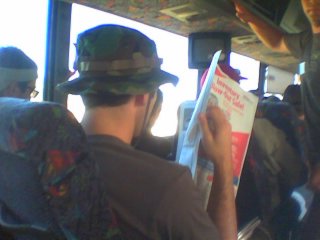
Once in the field, we had a woman added to our five-man fire team, and then we were set off to our leadership exercises.




The Marines believe that leadership consists substantially of making quick decisions under time pressure, communicating those decisions to those you supervise, and taking feedback from your team, in a constant feedback loop. Each fire team from Marshall spent 15 minutes trying to complete each of several challenges that Marines use during basic training for all recruits. Each challenge has physical and mental components; there is a clearly-articulated objective, a physical situation, and a set of tools each squad has available. The team, and, especially, the leader, must figure out how to use the tools to overcome the situation and accomplish the objective. Some of these challenges include:
- Get ammunition past a “destroyed bridge”, a series of posts, representing bridge supports, a few feet off of the ground. We had to get an gravel-filled ammo box representing, well, an ammo box, from one end to the other, using three boards.

In this exercise, we learned that I’m a pretty good leader (and I enjoy leading!), and that my balance ain’t that good.
- Get medical supplies through past another “destroyed bridge”, some chains hung from two metal rails. We had one wooden plank to get the gravel-filled ammo box representing the medical supplies from one end to the other.





In this exercise, we learned a really valuable lesson: despite starting strong, we ended up failing because we didn’t keep our leader out of the action. With the leader too caught up in the moment-to-moment details, we got stuck moving from one opportunity to another and lost the big picture. It’s very important to give the leader space to have perspective!
- Rescue a wounded man, represented by a dummy, from inside a “destroyed sewer”, a large metal pipe with a platform past one end. We completed this one in record time and overcame our weak start — almost every group was too indecisive and took too long on their first challenge — to succeed at three challenges in a row (we ended up completing four out of seven successfully).
- Carry a wounded soldier (played by a real person!) across a raging river (played by gravel), walking on one metal wire and holding onto another wire above your head. In this event we learned several things: that a fireman’s carry is an easy way to carry a person, that poor Candace is okay if she’s repeatedly dropped on her head, and that it’s no good when the leader of a challenge just disappears.
- Place an explosive (guess what — represented by a gravel-filled ammo box) in an enemy blockhouse that we had to enter from above using only two wooden logs. Remember, you can’t touch the red parts!

In this exercise, we learned that one of our team members was a really strong gymnast who could lift himself up easily over these wooden logs. Also, that it was good if most of us just shut up and let people do their job. Also, Dierdre learned that it sucked to drag Fred:
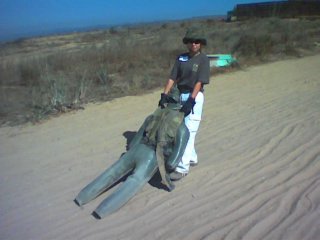
Oh yes, Fred. So, if you died — touched the red-painted part or the gravel, which represented water — you could only get your life back by dragging Fred 100 yards down a dusty dirt track and back again. There were four Freds so four people could go at once, each dragging a 200-pound dummy in a flak jacket.
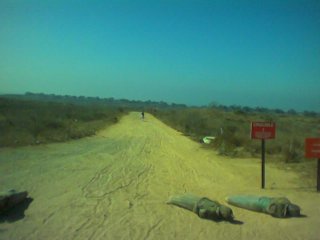 Sometimes, whole teams would die and everybody would get to drag a dummy.
Sometimes, whole teams would die and everybody would get to drag a dummy.
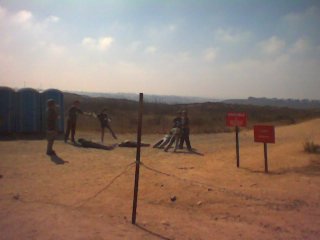 You couldn’t get away with anything because the Marines were always watching (they were also watching for safety violations):
You couldn’t get away with anything because the Marines were always watching (they were also watching for safety violations):
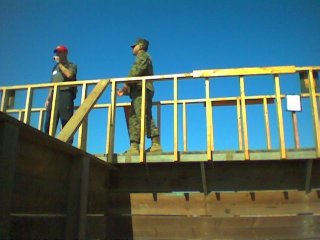
In a break between challenges they fed us a tasty bag lunch with chips and cookies and a roast beef sandwich. However, I believe that the below photo tells us a lot about the military:

At the end, of the day, everybody was wiped out from the physical and mental (!) exertion:

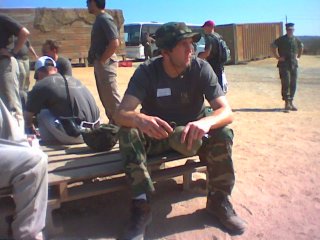
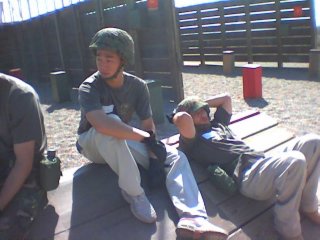
But learning from your experiences is half the battle. So, led by our class Marines, we had a debriefing.
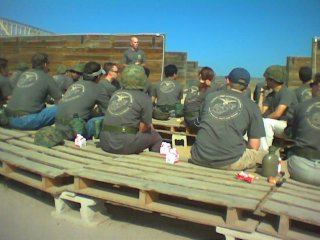 Ooo, everybody watch the Cobra!
Ooo, everybody watch the Cobra!
 Everybody seemed to agree, in each exercise, we had to carry our our OODA Loop quickly and efficiently, devise a plan, adapt dynamically, but keep an overall “vision.” Decisive leadership and a real “head” to our body was a must. The leader had to listen to his or her subordinates, let them develop plans, and choose from and develop these plans, then make sure the plan was properly implemented in the heat and disorder of the moment. Every subordinate had to take initiative and speak up as the situation developed. In the end, I felt our team was strong and effective. We only failed on three tasks, one because we were just getting started and one because a distracted team member didn’t watch what they were doing. With more practice, we could have suceeded at all three.
Everybody seemed to agree, in each exercise, we had to carry our our OODA Loop quickly and efficiently, devise a plan, adapt dynamically, but keep an overall “vision.” Decisive leadership and a real “head” to our body was a must. The leader had to listen to his or her subordinates, let them develop plans, and choose from and develop these plans, then make sure the plan was properly implemented in the heat and disorder of the moment. Every subordinate had to take initiative and speak up as the situation developed. In the end, I felt our team was strong and effective. We only failed on three tasks, one because we were just getting started and one because a distracted team member didn’t watch what they were doing. With more practice, we could have suceeded at all three.
Then it was off home. On the bus back, everybody could only think of one thing:
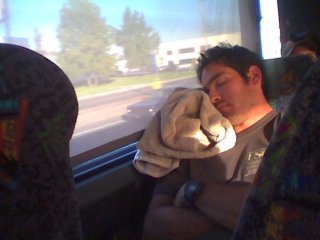
In case it’s not obvious, I really enjoyed my leadership training experience. While I don’t think that Marine leadership techniques are the end-all of leadership, I think there was a lot good there to learn (see my notes, if you haven’t already). I got a lot to think about, in terms of the importance of decisiveness, in terms of how to think, in terms of the importance of values and a basic, consistent approach, and in terms of how I’d best relate to those I supervise in the future. I rediscovered that I enjoyed leading, and was remided how nice it is to be lead by someone decisive, consistent, open to new ideas and with a vision. All of these seem to me to be fundamental parts of Marine leadership that are applicable to the business environment.
And I think the Marines gained a lot as well. Let’s face it, the military doesn’t always get the best rap in the business world. Doctrinaire, conservative, hierarchical, unoriginal, rigid — all of these are descriptions that are commonly attached to veterans. And who wants to hire someone you’d describe that way? Certainly not a small company, or a dynamic company, or a company that’s making waves — the kinds of companies at which I, and I think most Marshall students, would like to find ourselves. After a day at Camp Pendleton, I’m not sure I’d use any of those adjectives to describe a military man again. The upshot? I’ll be much more likely to hire a veteran in the future than I would have otherwise. A business suggestion to the Marines: if you’ve got training assets that are unused a few days a month, invite businesses by for an experience like we had. I bet you’ll improve your standing and your employees’ post-discharge employment opportunities, in no time. Plus, hey, who wouldn’t pay for a day of leadership training for mid-level executives? I’m talking revenue stream, baby!
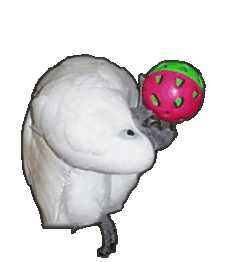
Wow! go GI-Wade!!
ugh, it omitted the most important part!
< olive_oyl_voice >
I just love a man in yooooooo-niform!
< olive_oyl_voice >
oh, whatever. >:-(